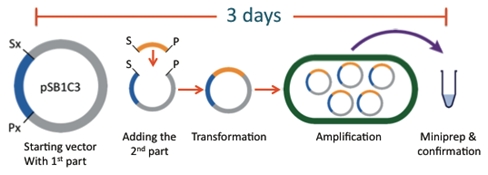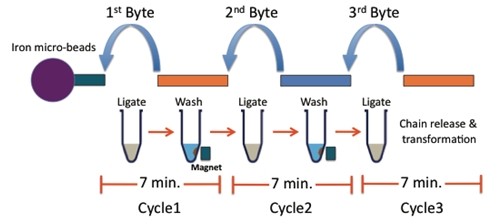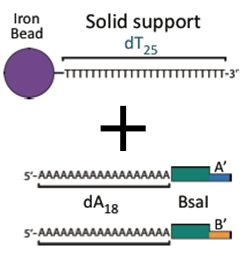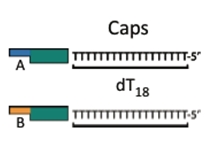Team:Alberta/biobyte2
From 2010.igem.org
(New page: {{Team:Alberta/Head}} {{Team:Alberta/navbar|project=selected}} {{Team:Alberta/beginLeftSideBar}} {{Team:Alberta/endLeftSideBar}} {{Team:Alberta/beginRightSideBar}} {{Team:Alberta/endRight...) |
|||
| Line 13: | Line 13: | ||
<div id="horiz-line"></div> | <div id="horiz-line"></div> | ||
| - | + | The traditional "BioBrick" construction method, while well suited to simple plasmid construction tasks, is a very time consuming process | |
| + | when larger, more complicated plasmids are attempted. Each cycle of adding a part to a BioBrick backbone takes at least three days. | ||
| + | |||
| + | [[Image:team-alberta-biobrick-tour.jpg]] | ||
| + | |||
| + | The "BioBytes Version 2.0" construction method has been shown to create (insert actual data here) plasmids from up to 8 separate parts in | ||
| + | an afternoon's work. This is a vast improvement. | ||
| + | |||
| + | [[Image:team-alberta-building-tour.jpg]] | ||
| + | |||
| + | ==BioBytes Components== | ||
| + | <div id="horiz-line"></div> | ||
| + | |||
The method has three main components: | The method has three main components: | ||
[[Image:team-alberta-anchor-tour.jpg|float=left]] | [[Image:team-alberta-anchor-tour.jpg|float=left]] | ||
| - | ==The Anchor== | + | ====The Anchor==== |
A ferro-magnetic bead attached to a piece of DNA. This piece serves as the initial piece from which we assemble a DNA construct. The bead allows us to manipulate the DNA with magnets making washing and subsequent attachments easier. | A ferro-magnetic bead attached to a piece of DNA. This piece serves as the initial piece from which we assemble a DNA construct. The bead allows us to manipulate the DNA with magnets making washing and subsequent attachments easier. | ||
[[Image:team-alberta-bytes-tour.jpg|float=left]] | [[Image:team-alberta-bytes-tour.jpg|float=left]] | ||
| - | ==The | + | ====The BioBytes==== |
DNA fragments that can be attached together to build up a larger construct. There are two types of pieces, AB and BA. The A end can join only with another A end and the B end can join only with another B end. As a result pieces can only be joined in a single orientation. | DNA fragments that can be attached together to build up a larger construct. There are two types of pieces, AB and BA. The A end can join only with another A end and the B end can join only with another B end. As a result pieces can only be joined in a single orientation. | ||
[[Image:team-alberta-cap-tour.jpg|float=left]] | [[Image:team-alberta-cap-tour.jpg|float=left]] | ||
| - | ==The | + | ====The Cap==== |
A DNA fragment that finishes off a construct and allows for circularization of the construct into a plasmid. | A DNA fragment that finishes off a construct and allows for circularization of the construct into a plasmid. | ||
| - | + | ||
| - | + | ||
The process of building a plasmid is more elegant and more rapid than the current biobyte system! | The process of building a plasmid is more elegant and more rapid than the current biobyte system! | ||
[[Image:team-alberta-biobyteprocess-tour.jpg]] | [[Image:team-alberta-biobyteprocess-tour.jpg]] | ||
Revision as of 08:58, 26 October 2010
BioBytes Version 2.0
Accelerating plasmid construction
The traditional "BioBrick" construction method, while well suited to simple plasmid construction tasks, is a very time consuming process when larger, more complicated plasmids are attempted. Each cycle of adding a part to a BioBrick backbone takes at least three days.
The "BioBytes Version 2.0" construction method has been shown to create (insert actual data here) plasmids from up to 8 separate parts in an afternoon's work. This is a vast improvement.
BioBytes Components
The method has three main components:
The Anchor
A ferro-magnetic bead attached to a piece of DNA. This piece serves as the initial piece from which we assemble a DNA construct. The bead allows us to manipulate the DNA with magnets making washing and subsequent attachments easier.
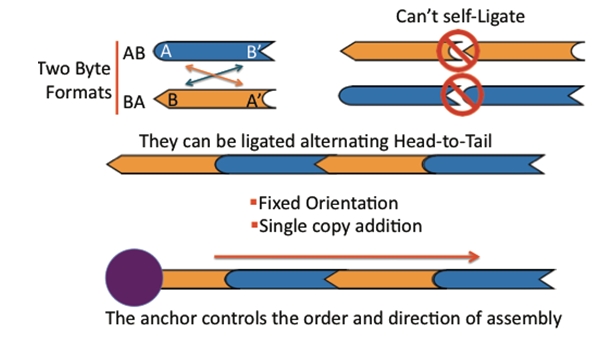
The BioBytes
DNA fragments that can be attached together to build up a larger construct. There are two types of pieces, AB and BA. The A end can join only with another A end and the B end can join only with another B end. As a result pieces can only be joined in a single orientation.
The Cap
A DNA fragment that finishes off a construct and allows for circularization of the construct into a plasmid.
The process of building a plasmid is more elegant and more rapid than the current biobyte system!
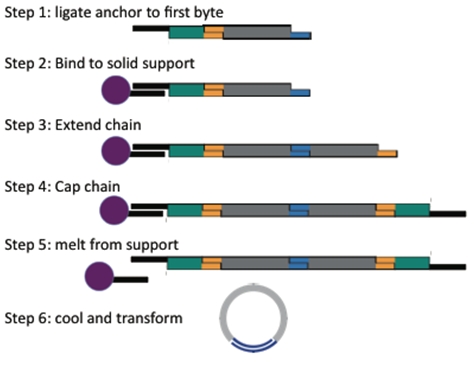
Starting with an anchor, add the first piece and ligate.
Then hold the single piece construct in the tube by placing it on the magnetic rack. Now you can wash away most of the excess of piece 1.
Add the next piece and repeat until you have added all the pieces you want.
Then add the cap.
Now just heat to release the anchor and open up the cap, upon cooling the construct will circularize.
Easy!
Using this process we were able to assemble eight pieces in an afternoon!
 "
"

